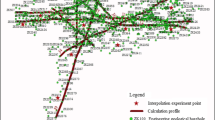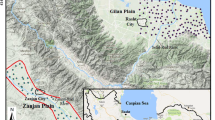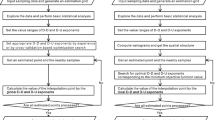Abstract
The adaptive inverse distance weighting (IDW) interpolation method shows improved computational advantages for building high-precision 3D geological models. However, in the case of varying geological borehole distribution characteristics, the statistical range of local adjacent points and the type of membership function are two important factors that affect the adaptive calculation of the weight power value in the IDW method. Therefore, this study attempts to build a general adaptive IDW model unaffected by the spatial distribution of geological boreholes sample data. This study uses a combination of nearest neighbor point statistics and membership function mapping to modify the IDW weights automatically. Moreover, it investigates the accuracy of IDW interpolation under two types of nearest neighbor point statistics ranges (fixed number and area) and three types of membership functions (triangle, trapezoidal, and Gaussian) interactions. The results showed that fixing the search window to determine the local neighbor statistics range and utilizing the triangle membership function to map adjustment weights exhibit strong distribution patterns. The minimum interpolation relative error for 10 sample boreholes reached 0.86%, whereas the average minimum interpolation relative error was 18.80%. Each borehole achieved optimal interpolation accuracy. The research findings significantly impact building adaptive spatial interpolation techniques and high-precision 3D geological models.







Similar content being viewed by others
Data Availability
The data used to support the findings of this study are available from the corresponding author upon reasonable request.
References
Alam N, Khalif K, Jaini NI (2023) Application of intuitionistic Z-Numbers in supplier selection. Intell Autom Soft Comput 35(1):47–61
Arkoc O (2022) Modeling of spatiotemporal variations of groundwater levels using different interpolation methods with the aid of GIS, case study from Ergene Basin, Turkey. Model Earth Syst Environ 8(1):967–976
Bai SX, Du S, Liu HP, Lin SQ, Zhao XD, Wang ZJ, Wang ZP (2022) The causal and independent effect of ozone exposure during pregnancy on the risk of preterm birth: evidence from northern China. Environ Res 214(1):113879
Barrena-Gonzalez J, Contador JFL, Fernandez MP (2022) Mapping Soil Properties at a Regional Scale: assessing deterministic vs. Geostatistical Interpolat Methods Different Soil Depths Sustain 14(16):10049
Benati S, Puerto J, Rodriguez-Chia AM, Temprano F (2022) A mathematical programming approach to overlapping community detection. Phys A-Statistical Mech its Appl 602:127628
Berens AS, Palmer T, Dutton ND, Lavery A, Moore M (2020) Using search-constrained inverse distance weight modeling for near real-time riverine flood modeling: Harris County, Texas, USA before, during, and after Hurricane Harvey. Nat Hazards 105(1):277–292
Caballero SR, Bheemasetti TV, Puppala AJ, Chakraborty S (2022) Geotechnical visualization and three-dimensional geostatistics modeling of highly variable soils of a hydraulic fill dam. J Geotech GeoEnviron Eng 148(11):05022006
Cavalcante T, Weber MM, Barnett AA (2022) Combining geospatial abundance and ecological niche models to identify high-priority areas for conservation: the neglected role of broadscale interspecific competition. Front Ecol Evol 10:915325
Chen HY, Lin KP (2022) Fuzzy supplier selection model based on lifetime performance index. Expert Syst Appl 208:118135
Dai JH, Luo L, Xiao L, Jia L, Li XP (2022) An intelligent fuzzy robustness ZNN model with fixed-time convergence for time-variant Stein matrix equation. Int J Intell Syst 37(12):11670–11691
Dhanasekaran Y, Murugesan P (2022) Improved bias value and new membership function to enhance the performance of fuzzy support vector machine. Expert Syst Appl 208:118003
Eshete GD, Asitatikie AN, Almnewu HN, Belew AZ (2022) Analysis of the spatial and temporal variability of direct rainfall in Lake Tana, Ethiopia. Appl Water Sci 12(9):227
Gao J, Lin X (2020) Mathematical Interpolation and correction of three-dimensional modelling of high-speed railway. Intell Autom Soft Comput 26(5):1023–1034
Gutierrez-Avila I, Arfer KB, Carrion D, Rush J, Kloog I, Naeger AR, Grutter M, Paramo-Figueroa VH, Riojas-Rodriguez H, Just AC (2022) Prediction of daily mean and one-hour maximum PM2.5 concentrations and applications in Central Mexico using satellite-based machine-learning models. J Exposure Sci Environ Epidemiol 32(6):917–925
Irakarama M, Thierry-Coudon M, Zakari M, Caumon G (2022) Finite element implicit 3D Subsurface Structural modeling. Comput Aided Des 149:103267
Khoo HW, Ng YH, Tan CK (2022) Enhanced radio map interpolation methods based on dimensionality reduction and clustering. Electronics 11(16):2581
Kim E, Nam SH, Ahn CH, Lee S, Koo JW, Hwang TM (2022) Comparison of spatial interpolation methods for distribution map an unmanned surface vehicle data for chlorophyll-a monitoring in the stream. Environ Technol Innov 28:102637
Li HL, Li ZH, Ouyang YP, Yang LF, Deng YG, Jiang QB, Deng T, Shang P, Lin YH, Zeng HX (2022a) Application of principal component analysis and a spectrum-area fractal model to identify geochemical anomalies associated with vanadium mineralization in northeastern Jiangxi Province, South China. Geochemistry-Exploration Environ Anal 22(3):090
Li J, Liu PR, Wang XY, Cui H, Ma YR (2022b) 3D geological implicit modeling method of regular voxel splitting based on layered interpolation data. Sci Rep 12(1):13840
Li ZP, Zhong DY, Wang LG, Tang QW, Wu ZH (2022c) Mesh Processing for snapping feature points and polylines in Orebody modeling. Mathematics 10(15):2593
Liu H, Chen SZ, Hou MQ, He L (2020) Improved inverse distance weighting method application considering spatial autocorrelation in 3D geological modeling[J]. Earth Sci Inf 13(3):619–632
Liu Z, Zhang ZL, Zhou CY, Ming WH, Du ZC (2021a) An adaptive Inverse-Distance weighting interpolation method considering spatial differentiation in 3D geological modeling. Geosciences 11(2):51
Liu ZN, Yu XY, Jia LF, Wang YS, Song YC, Meng HD (2021b) The influence ;of distance weight on the inverse distance weighted method for ore-grade estimation. Sci Rep 11(1):2689
Liu SL, Li WJ, Gao P, Sun YB (2022) Modeling and performance analysis of gas leakage emergency disposal process in gas transmission station based on Stochastic Petri nets. Reliab Eng Syst Saf 226:108708
Lu GY, Wong DW (2008) An adaptive inverse-distance weighting spatial interpolation technique. Comput Geosci 34(9):1044–1055
Malinowska A, Cui XM, Salmi EF, Hejmanowski R (2022) A novel fuzzy approach to gas pipeline risk assessment under influence of ground movement. Int J Coal Sci Technol 9(1):47
Mei G (2014) Summary on several key techniques in 3D geological modeling. Scientific World Journal, p 723832
Nasir MJ, Tufail M, Ayaz T, Khan S, Khan AZ, Lei M (2022) Groundwater quality assessment and its vulnerability to pollution: a study of district Nowshera, Khyber Pakhtunkhwa, Pakistan. Environ Monit Assess 194(10):692
Nistor MM, Rahardjo H, Satyanaga A, Hao KZ, Xiaosheng Q, Sham AWL (2020) Investigation of groundwater table distribution using borehole piezometer data interpolation: case study of Singapore. Eng Geol 271:105590
Obianyo JI, Okey OE, Alaneme GU (2022) Assessment of cost overrun factors in construction projects in Nigeria using fuzzy logic. Innovative Infrastructure Solutions 7(5):304
Ohlert PL, Bach M, Breuer L (2022) Accuracy assessment of inverse distance weighting interpolation of groundwater nitrate concentrations in Bavaria (Germany). Environmental Science and Pollution Research. https://doi.org/10.1007/s11356-022-22670-0
Rena V, Vishwakarma CA, Singh P, Roy N, Asthana H, Kamal V, Kumar P, Mukherjee S (2022) Hydrogeological investigation of fluoride ion in groundwater of Ruparail and Banganga basins, Bharatpur district, Rajasthan, India. Environ Earth Sci 81(17):430
Saenz-Ceja JE, Mendoza ME (2022) Latitudinal gradient of fire return interval in conifer forests of western North America. Phys Geogr. https://doi.org/10.1080/02723646.2022.2108206
Shah SHIA, Yan JG, Jahangir Z, Tariq A, Aslam B (2022) Integrated geophysical technique for groundwater salinity delineation, an approach to agriculture sustainability for Nankana Sahib Area, Pakistan. Geomatics Nat Hazards Risk 13(1):1043–1064
Shi YC, He WG, Zhao J, Hu AY, Pan JN, Wang HZ, Zhu HL (2020) Expected output calculation based on inverse distance weighting and its application in anomaly detection of distributed photovoltaic power stations. J Clean Prod 253:119965
Smart PDS, Thanammal KK, Sujatha SS (2023) An Ontology based Multilayer Perceptron for object detection. Comput Syst Sci Eng 44(3):2065–2080
Starling AP, Wood C, Liu CN, Kechris K, Yang IV, Friedman C, Thomas DSK, Peel JL, Adgate JL, Magzamen S (2022) Ambient air pollution during pregnancy and DNA methylation in umbilical cord blood, with potential mediation of associations with infant adiposity: the healthy start study. Environ Res 214(1):113881
Sukkuea A, Heednacram A (2022) Prediction on spatial elevation using improved kriging algorithms: an application in environmental management. Expert Syst Appl 207:117971
Theodosopoulou Z, Kourtis IM, Bellos V, Apostolopoulos K, Potsiou C, Tsihrintzis VA (2022) A fast Data-Driven Tool for Flood Risk Assessment in Urban Areas. Hydrology 9(8):147
Wang ZG, Qu HG, Wu ZX, Yang HJ, Du QL (2016) Formal representation of 3D structural geological models. Comput Geosci 90:10–23
Wang YB, Qin N, Zhao N (2017) Delaunay Graph based Inverse Distance weighting for fast dynamic meshing. Communications in Computational Physics. Commun Comput Phys 21(5):1282–1309
Wu ZH, Bi L, Zhong DY, Zhang J, Tang QW, Jia MT (2022) Orebody modeling Method based on the Coons Surface Interpolation. Minerals 12(8):997
Xin Q, He ZW (2020) Three dimensional stratum interpolation and visualization based on section and borehole data from jointing the moving least square method and poisson reconstruction method. Earth Sci Inf 13:1341–1349
Yang W, Zhao Y, Wang D, Wu H, Lin A, He L (2020) Using principal components analysis and IDW interpolation to determine spatial and temporal changes of surface water quality of Xin’anjiang river in Huangshan, China. Int J Environ Res Public Health 17(8):2942
Zhang T, Zhou YY, Zhao KG, Zhu ZY, Asrar GR, Zhao X (2022) Gap-filling MODIS daily aerosol optical depth products by developing a spatiotemporal fitting algorithm. GIScience & Remote Sensing 59(1):762–781
Zhao KX, Dai YP, Jia ZY, Ji Y (2022) General fuzzy C-Means clustering strategy: using objective function to Control Fuzziness of Clustering results. IEEE Trans Fuzzy Syst 30(9):3601–3616
Funding
This work was supported by the Key Natural science research project of Anhui Provincial Department of Education (No.2022AH051114, No.KJ2021A1080), Major natural science research project of Anhui Provincial Department of Education (No. KJ2021ZD0131), Scientific research project of Chuzhou University (No.2020qd47, No.2022XJZD04).
Author information
Authors and Affiliations
Contributions
Conceptualization, Huan Liu and Weitao Li; methodology, Huan Liu and Ling Bao; data collection and analysis, Huan Liu and Yuqing Mei; software and visualization, Lei Cheng and Shuangxi Gu; validation, Weibo Zeng and Jing Guo; writing, Huan Liu; review and editing, Weitao Li and Ling Bao.
Corresponding author
Ethics declarations
Conflict of interest
The authors declare no conflict of interest.
Additional information
Communicated by H. Babaie.
Publisher’s Note
Springer Nature remains neutral with regard to jurisdictional claims in published maps and institutional affiliations.
Electronic supplementary material
Below is the link to the electronic supplementary material.
Rights and permissions
Springer Nature or its licensor (e.g. a society or other partner) holds exclusive rights to this article under a publishing agreement with the author(s) or other rightsholder(s); author self-archiving of the accepted manuscript version of this article is solely governed by the terms of such publishing agreement and applicable law.
About this article
Cite this article
Liu, H., Li, W., Zeng, W. et al. Influence of adaptive inverse distance weighting method under membership function mapping on the interpolation accuracy of geological boreholes. Earth Sci Inform 16, 2767–2779 (2023). https://doi.org/10.1007/s12145-023-01074-9
Received:
Accepted:
Published:
Issue Date:
DOI: https://doi.org/10.1007/s12145-023-01074-9




